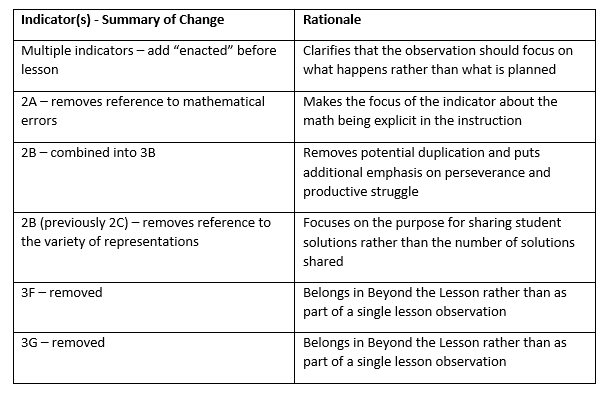Student Achievement Partners originally created the Instructional Practice Guide because we saw an unmet need among teachers and those who support them. Many of the existing options for classroom observation rubrics have been designed to focus on instructional practice decisions such as how to group students, how to engage them, and how to structure activities without reflecting upon the content that is being taught. Discussion about the content and how well students are learning is often treated separately. This did not reflect research that showed that the highest-impact feedback and professional learning are framed in the context of both instructional content and classroom practice strategies. To learn more about this research, read Aligning Content and Practice: The Design of the Instructional Practice Guide.
The Instructional Practice Guide, created by Student Achievement Partners in 2012, prioritizes standards-aligned instructional content and names a small number of observable classroom practices. Because research supports that classroom observation is likely more reliable and useful if observers are responsible for providing ratings on fewer discrete measures (Bill and Melinda Gates Foundation, 2012), the IPG deliberately does not attend to other components commonly found in observation rubrics (e.g., professionalism and collegiality) and relentlessly prioritizes fewer indicators that are most directly focused on standards-aligned instruction. By recording observations on these classroom practices, coaches and teachers can gauge whether students are engaging with content in ways that address the expectations of college- and career-ready standards for ELA/literacy and mathematics.
We created the Instructional Practice Guide (IPG) to give teachers a rubric that would help them reflect on the instructional practice moves that are expected in a classroom where content is aligned to college- and career-ready standards. The IPG is grounded in the research-based content progression shared by the Common Core and other college- and career-ready standards in ELA/literacy and mathematics. The rubric is divided into the Core Actions teachers should be taking, and each Core Action consists of indicators which further describe teacher and student behaviors that exemplify college- and career-ready instruction.
Identifying Improvements
Over the last several years, thousands of people reported using the rubric and training others to use it—altering the way they structured feedback and reflection and what topics they chose to focus on during coaching conversations. We have received wonderful feedback about the positive impacts that came from using the IPG, as well as feedback on how we could improve the tool and make it easier to use.
In 2017, Student Achievement Partners began analyzing all the data captured over multiple years of IPG use in the field, with the intention of revising the tool for the 2018–19 school year. The analysis included collecting feedback, IPG adaptations, and anecdotes from individuals and organizations with significant experience regularly using the IPG in schools and with educators. It also incorporated lessons learned from research partners, some of whom were training and norming reviewers using a similar observation tool. Finally, it took into account feedback collected through a variety of interactions—both online and in-person—from individuals exploring ways to implement the IPG in their local contexts.
We consolidated and distilled the information we collected and developed a set of recommended revisions. Throughout the process, we paid particular attention to places where the focus of specific indicators was not distinct and/or overlapped with other indicators and places where indicators or rating language required that the observer attend to more than one key concept or idea. Wherever possible, we clarified language and expectations and removed language that was not necessary.
Curious what exactly changed and why? Peruse the tables below. Some of the changes are subtle—you might not even notice them if you’ve used the rubric before—but as a whole they create a better experience, where teachers can quickly zero in on what matters most in the classroom.
Key Updates: ELA/Literacy
- Changes to the front matter (streamlining)
- K–2 Foundational Skills “option” to be removed. A separate K–2 Foundational Skills Observation Tool will be created in its place.
- Indicator-level changes:
Key Updates: Mathematics
- Changes to the front matter (streamlining)
- We removed the reference to mathematical errors from indicator language. We have instead included a separate field and the following instruction, “If any uncorrected mathematical errors are made during the context of the lesson (instruction, materials, or classroom displays), note them here.”
- Indicator-level changes:
We’re grateful to each person who took time to help use revise the Instructional Practice Guide. We hope you see your input reflected! The IPG was originally created to address an unmet teacher need, so it’s critical to us that the rubric continues to meet real classroom needs and reflect real classroom use cases.
Have questions about the changes? Email info@studentsachieve.net. Additionally, Student Achievement Partners frequently has opportunities to provide feedback on tools and resources (both existing tools like the IPG, and things that are still under development). If you’re interested in learning about opportunities to provide feedback, please complete this short form.


















